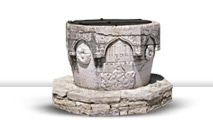
- Sečovlje Salt Pans - Dragonja River Valley
- Sv. Peter - Nova vas - Padna
- Pomjan - Nature Park: Karst Edge - Socerb
- Črni Kal - Osp - Kubed
- Momjan - Grožnjan - Pietrapelosa - Mirna
- Baštija - Kostanjica - Parenzana
- Oprtalj - Završje - Livade - Zrenj
- Istarske toplice - Motovun Forest - Višnjan
- Cave Mramornica - Feštini Kingdom - Cave Baredine
- Lim Bay - Kloštar - Kontija - Dvigrad
- Kanfanar - Bale - Palud - Vodnjan - Brijuni - Fažana
- Svetvinčenat - Tinjan - Pićan - Gračišće
- Belaj - Šumber - Kožljak - Paz
- Čepićko Field - Kršan - Boljun Castle - Lupoglav
- Plomin - Kvarner Gulf - Brseč
- Nature park Učka - Mošćenice
Lim Bay - Kloštar - Kontija - Dvigrad
Dvigrad
This is a special site. It was neither burnt nor destroyed by the war. It simply died – remaining without its inhabitants. It stood not far from Kanfanar above the Lim valley and had a superior position in terms of medieval roads. Its beginnings date back to prehistoric times, when it was part of the one-time hill-fort within the Roman province, at the border between the Pula and Poreč ager. Its name speaks originally of two towns. The present-day ruins are remains of the northern town Moncastello, while the other, Parentin, abandoned in the 10th c., fell into ruins and was pulled down.
Its remains prove it was once a developed and rich town. Later, the barbarians on the one hand and diseases on the other, encouraged people to abandon Dvigrad. It fought against the Genoese, it was under the Venetians, attacked by the Uskoks, but always remained invincible. In the 17th c., when Istria was ravaged by malaria and the plague, its inhabitants left the town for good and fled to Kanfanar.
All that remains of the one-time town are the town gate, two rings of town walls, several defense towers and segments of houses that formed Dvigrad. The parish house and the building of the town guard near the main entrance are its best preserved parts. However, we must mention the remains of the Church of St. Sophia on the main elevation of Dvigrad. It was built in the 11th c. on the ruins of an earlier pre-Romanesque church. The pulpit from the 15th c. that is presently kept in the parish church in Kanfanar, bears the relief with the representation of St. Sophia holding two towns. Below the town walls is the Church of St. Mary of Lakuć from the 15th c., painted with frescoes.
Напечатай страницу Отправь другу
















